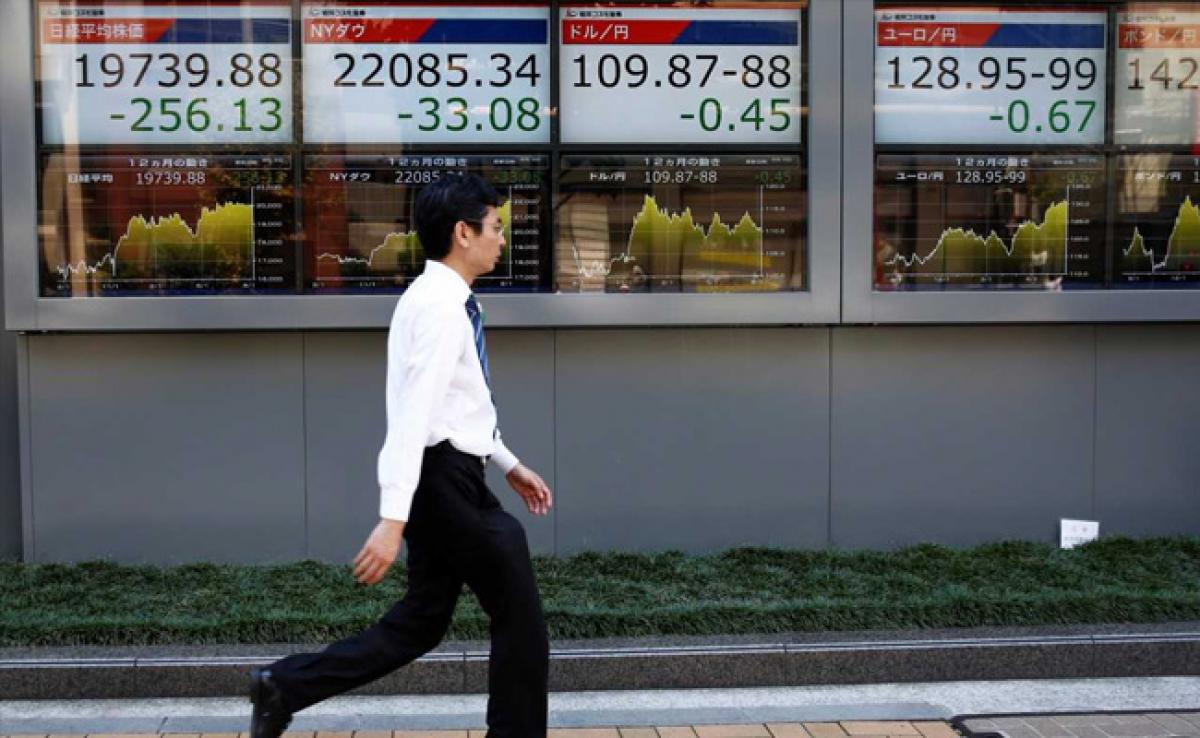Live
- Hyderabad: Efforts to stave off encroachments on city temple land yielding results
- YIS University rolls out 3 job-oriented courses
- Rail passengers face online booking hiccups
- Oh! Sankranti bus travel turns dearer from today
- CPM demands Rs 15k Rythu Bharosa aid
- Global meet in Manipal to explore ancient wisdom and modern therapy
- Homage paid to victims of Tirupati stampede
- Splendour marks Teppotsavam in Bhadrachalam
- Tirumala dazzles with colourful decorations
- Talpagiri temple decked up for Ekadasi
Just In

Asian shares rose on Tuesday, tracking record closes on Wall Street and upbeat economic data that lifted U.S. Treasury yields and the dollar, although weaker oil prices took their toll on some market segments.
Asian shares rose on Tuesday, tracking record closes on Wall Street and upbeat economic data that lifted U.S. Treasury yields and the dollar, although weaker oil prices took their toll on some market segments.
MSCI’s broadest index of Asia-Pacific shares outside Japan .MIAPJ0000PUS was 0.4 percent higher, clawing back losses from earlier in the Asian day.
Japan's Nikkei stock index .N225 added 0.8 percent, as a tailwind from a weaker yen helped it sail to its highest levels since August 2015.
Australian shares slipped 0.4 percent, pressured by consumer and energy shares, as investors awaited the Reserve Bank of Australia’s (RBA) policy decision at 0330 GMT. The energy index .AXEJ skidded 1 percent in line with weaker crude prices.
The central bank is widely expected to keep interest rates on hold at a record low of 1.5 percent with the focus on its assessment of the economy and how that could impact is monetary policy.
Crude oil futures extended losses after tumbling on Monday, as a rise in U.S. drilling and higher OPEC output put the brakes on their recent rally and rekindled concerns about oversupply.
Brent crude LCOc1 slipped 0.4 percent to $55.88 a barrel, after marking a third-quarter gain of about 20 percent. U.S. crude CLc1 fell 0.3 percent to $50.42.
“The fourth quarter is not too kind to the price of oil, as we switch from summer demand to expectations of winter demand,” said Jonathan Barratt, chief investment officer at Ayers Alliance in Sydney.
On Wall Street on Monday, U.S. stocks started the fourth quarter on a strong note, with all three major indexes closing at record highs after data underscored strength in the economy. [.N]
A measure of U.S. manufacturing activity surged to a near 13-1/2-year high in September. Disruptions to the supply chains caused by Hurricanes Harvey and Irma resulted in factories taking longer to deliver goods and boosted raw material prices.
The Institute for Supply Management index rose to 60.8 in September, from 58.8 in August, exceeding expectations for a reading of 58.
U.S. construction spending also rebounded in August after two straight months of declines, boosted by increases in both private and public outlays.
The dollar stood tall, hoisted by rising U.S. Treasury yields. The yield on the benchmark 10-year note US10YT=RR hit its highest since mid-July on Monday after the upbeat data reinforced expectations that the Federal Reserve will increase U.S. interest rates in December for a third time this year.
“There are strengthening expectations about what the Fed will do for the balance of the year, namely one more rate increase and balance sheet reduction,” said Bill Northey, chief investment officer at U.S. Bank Private Client Group in Helena, Montana.
Due to the impact of the recent hurricanes, Northey said, “we’re going to get some data anomalies over the next few months, but as you step back and take a broader context around trends that exist right now, it is clear the U.S. economy is performing very well, and it will continue to be on an improving path.”
The dollar index, which tracks the greenback against a basket of six major rivals, added 0.3 percent to 93.840 .DXY, nudging up to its highest levels since late August.
The euro eased 0.2 percent to $1.1710 EUR=, facing pressure from Spain's biggest constitutional crisis in decades, after Sunday's violence-marred independence referendum in Catalonia opened the door for its wealthiest region to move for secession as early as this week.
The dollar added 0.3 percent against its Japanese counterpart to 113.08 yen JPY=, within sight of last week's two-month high of 113.26 yen.
Proposed U.S. tax code changes as well as the possibility that U.S. President Donald Trump will appoint a more hawkish Fed Chair also gave the dollar a lift.
Spot gold XAU= edged down slightly to $1,270.29 per ounce, after plumbing its lowest in nearly seven weeks on Monday as the dollar rose.

© 2025 Hyderabad Media House Limited/The Hans India. All rights reserved. Powered by hocalwire.com







